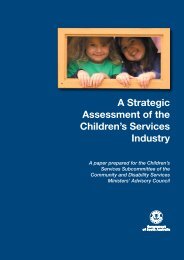Global Study On Child Poverty And Disparities (PDF) - Social Policy ...
Global Study On Child Poverty And Disparities (PDF) - Social Policy ...
Global Study On Child Poverty And Disparities (PDF) - Social Policy ...
You also want an ePaper? Increase the reach of your titles
YUMPU automatically turns print PDFs into web optimized ePapers that Google loves.
Overall <strong>Poverty</strong> in Vanuatu<br />
Before discussing new estimates of child poverty,<br />
it is useful to summarise earlier findings for<br />
general poverty levels (for households with and<br />
without children) in Vanuatu. An analysis of 2006<br />
household income and expenditure survey data<br />
(Government of Vanuatu, National Statistics<br />
Office, ADB and United Nations Development<br />
Programme, 2008) found that overall, 6 per cent<br />
of households, representing 7.4 per cent of the<br />
population, did not consume enough to meet basic<br />
food needs as defined by the FPL. Nationally,<br />
about 12.9 per cent of households, representing<br />
15.9 per cent of the population, spent less than<br />
needed to meet the BNPL. Port Vila exceeded the<br />
national average, with 27.2 per cent of households<br />
below the BNPL.<br />
The 2008 study also found that overall poverty in<br />
Vanuatu is relatively low in Pacific terms, with a<br />
national poverty gap index of 5.6, compared for<br />
example with 7.5 for Solomon Islands and 11.2<br />
for Fiji. However, the poverty gap index for Port<br />
Vila, at 10.6, was higher than for the rest of the<br />
country, suggesting a large difference between<br />
the better off and the poor in the national capital.<br />
The poverty gap index indicates that the average<br />
expenditure levels of households in poverty<br />
are well below the poverty line. Overall, these<br />
Figures indicate that Vanuatu experiences a<br />
slightly lower level of poverty severity than other<br />
Pacific countries, except in Port Vila (ADB, UNDP,<br />
Government of Vanuatu, 2008).<br />
New estimates of child poverty<br />
Estimates of child poverty using the Vanuatuspecific<br />
BNPL differ according to whether<br />
the poverty line is set at the national level or<br />
disaggregated by location.<br />
As shown in Figure 2.1, the total number of<br />
children in Vanuatu estimated to be living in<br />
households below the national BNPL in 2006<br />
was 14,953, or about 17 per cent of all children<br />
(see also Table A1.3 in annex 1 for provincial<br />
disaggregation). Of the total population including<br />
adults, 15.9 per cent were living in poverty as<br />
measured by this definition, compared to 17.0 per<br />
cent of children, meaning that children are overrepresented<br />
among the poor.<br />
About 40 per cent of all children in Torba, and<br />
about a quarter of all children in Tafea and<br />
Shefa, were living in poverty. Using this measure,<br />
Luganville and Port Vila have the lowest levels of<br />
child poverty, with about 5 per cent of children in<br />
these regions in poverty.<br />
Figure 2.1: <strong>Child</strong>ren living under the national<br />
Basic Needs <strong>Poverty</strong> Line (%)<br />
45<br />
40<br />
39.5<br />
35<br />
30<br />
26<br />
25<br />
22.6<br />
20<br />
17.1<br />
12.6 17<br />
15<br />
11<br />
10<br />
5.9<br />
4.9<br />
5<br />
0 Luganville Port Malampa Sanma Vanuatu Penama Shefa Tafea Torba<br />
Vila (Rural) (Rural)<br />
Source: Estimated from 2006 HIES.<br />
Based on the national BNPL, Torba ranks worst<br />
in the proportion of children living in poverty (40<br />
per cent). However, the actual number of children<br />
living in poverty is larger in Tafea (4,099) than<br />
in Torba (1,747), even though the percentage is<br />
lower in Tafea (26 per cent).<br />
Figure 2.2 shows the number and proportion of<br />
children living under the sub-national BNPLs,<br />
which include the regional non-food factors as<br />
described above. In Torba, a quarter of all children<br />
live in poverty as measured by the sub-national<br />
line, compared to 40 per cent when measured<br />
by the national line. In Luganville, child poverty<br />
based on the sub-national line is twice that<br />
measured by the national standard (11 per cent<br />
compared to 5 per cent), and in Port Vila it is 33<br />
per cent under the local standard, up from 6 per<br />
cent under the national standard.<br />
Figure 2.2: <strong>Child</strong>ren under the sub-national Basic<br />
Needs <strong>Poverty</strong> Line (%)<br />
40<br />
35<br />
30<br />
25<br />
20<br />
15<br />
10<br />
5<br />
0<br />
3.6<br />
4.7<br />
6.1 11.4<br />
Malampa Sanma Penama Luganville Vanuatu Shefa Tafea Torba Port<br />
(Rural) (Rural) Vila<br />
Source: Estimated from 2006 HIES.<br />
13.54 15.5<br />
International dollar-a-day poverty line<br />
The measurement of absolute global poverty<br />
is usually based on the US$1 per day PPP<br />
value. This measure is the basis of Goal 1 of the<br />
17.6<br />
24.2<br />
32.8<br />
36
















